Network monitoring is essential for maintaining IT systems and services’ performance, security, and reliability. However, with so many network monitoring tools available, choosing the right one for your organization’s needs can be challenging.
This blog will explore 17 of the best network monitoring tools, both open source and paid, and highlight their unique features and benefits. Whether you’re a small business or a large enterprise, there’s a tool on this list that can help you monitor your network performance effectively and efficiently.
So let’s dive in and discover the top network monitoring tools available today.
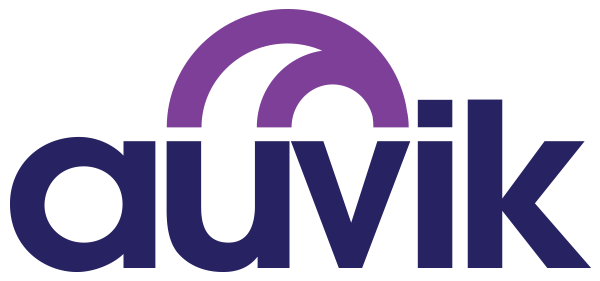
Auvik is a cloud-based networking monitoring tool. Auvik is the only tool offering automated network discovery, remote real-time network mapping, and comprehensive device monitoring in a user-friendly platform.
Auvik is best suited for IT teams as well as individuals that need comprehensive network monitoring and management capabilities, especially those with complex network infrastructure. It is also an excellent choice for managed service providers (MSPs) who need to manage multiple client networks efficiently.
Automated Network Discovery: Auvik automatically discovers all devices on your network, providing a complete inventory of your infrastructure.
Real-time Network Mapping: Auvik provides real-time visibility into your network topology, making it easy to identify potential issues and troubleshoot problems.
Comprehensive Device Monitoring: Auvik offers detailed monitoring of all network devices, including switches, routers, firewalls, and more, allowing you to quickly identify issues and take action.
Scalability: Auvik is designed to be scalable, so it can grow with your business as your network infrastructure expands.
Security: Auvik has an industry-standard Four-Tier architecture, with security protocols at every layer. This combines encrypted network data using AES-256, Data Isolation, Restricted Access etc.
Auvik's Customer Reviews
Auvik has the best user satisfaction level. Probably the maximum among its competitors.
As per Gartner.com (a leading global research and advisory company), Auvik got 4.5-star ratings from 78 customer reviews.
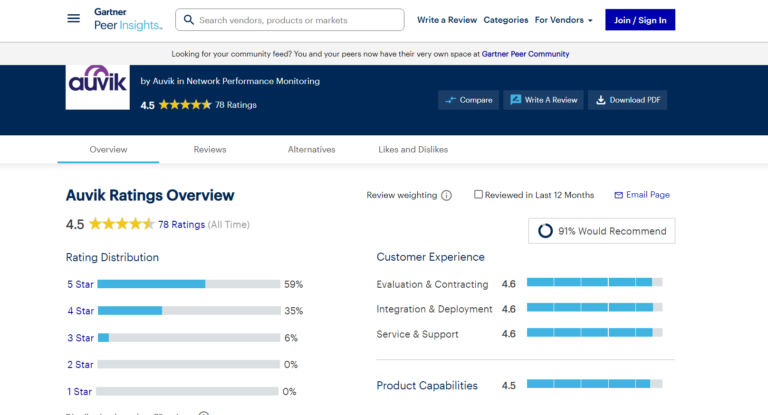
On G2.com, Auvik received 4.7-star ratings from 221 customer reviews.
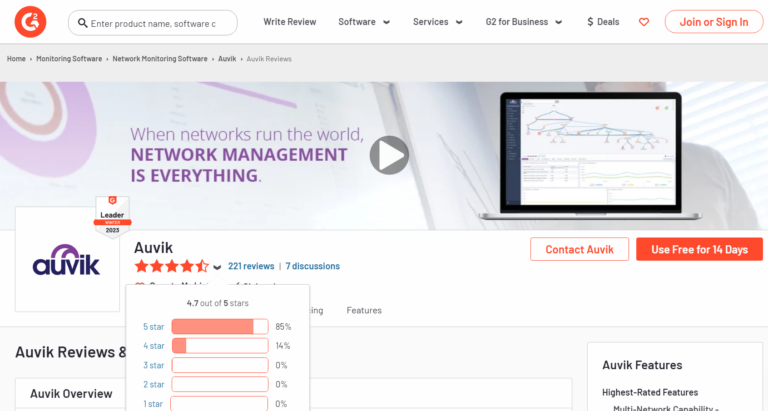
8.7 star ratings from 153 customer votes on TrustRdius.com. Also got the best tool of 2023 award based on customer satisfaction level.
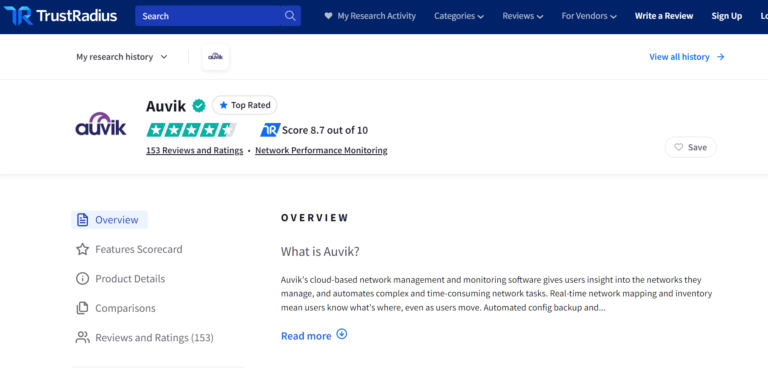
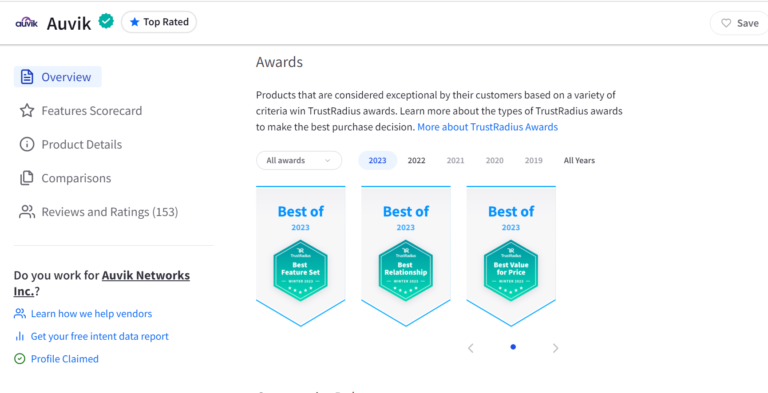
Similar high customer ratings on GetApp.com also. Here Auvik got 4.6-star ratings from 70 customers.
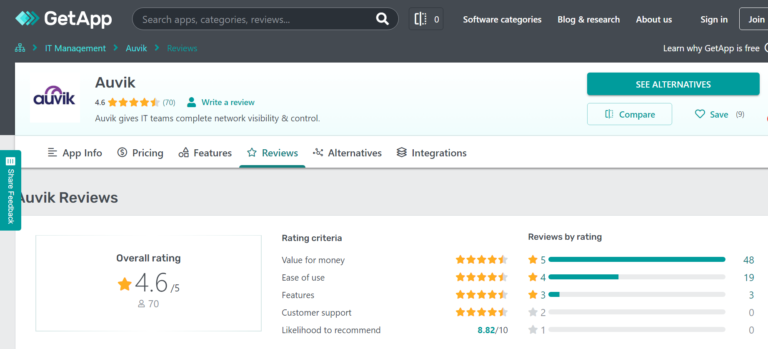
Supporting OS
Auvik supports multiple platforms, including Windows, macOS, and Linux. However, since Auvik is cloud-based, you can access it from any device with an internet connection and a web browser, regardless of the operating system. This makes it a versatile solution that can work for a wide range of businesses and IT teams.
PS: Auvik’s platform is designed to be responsive and optimized for mobile devices also, so you can monitor your network and receive alerts. However, some features of Auvik’s platform may be better suited for use on a desktop or laptop computer with a larger screen and a physical keyboard.
Auvik has a lot more other features. For the complete list, please click here
Auvik is a Freemium tool, so it is free for 14 days. You can sign up and can discuss your challenges with their technical team in order to get it fixed.
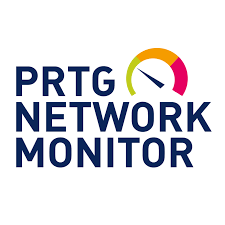
PRTG Network Monitor is a comprehensive network monitoring tool that offers an easy-to-use web interface, customizable dashboards, and a range of sensors for monitoring network performance. Its free version includes up to 100 sensors, making it a good option for small to medium-sized businesses.
PRTG Network Monitor's Features
PRTG Network Monitor provides comprehensive data collection and archiving features, allowing administrators to store and analyze historical performance data. This feature enables administrators to identify trends and forecast future capacity needs.
PRTG Network Monitor also supports cloud monitoring for popular cloud services such as Amazon Web Services and Microsoft Azure, making it easier for administrators to monitor and manage hybrid IT environments. The tool also supports virtualization monitoring for popular virtualization technologies such as VMware and Hyper-V, making it easier to monitor and manage virtualized infrastructure.
PRTG Network Monitor also offers advanced network mapping and visualization capabilities with support for custom maps. This feature provides administrators with a visual representation of the network topology and traffic flows, enabling them to quickly identify issues and troubleshoot problems. Additionally, the tool provides built-in security features such as SSL encryption and LDAP authentication, ensuring that sensitive data is protected. Lastly, PRTG Network Monitor offers high availability and scalability features that make it suitable for large and complex networks.

Splunk is a software platform designed to help businesses and organizations collect, index, and analyze machine-generated data from various sources such as applications, servers, network devices, and sensors.
It is a powerful tool for turning large amounts of machine-generated data into meaningful insights that can help businesses make data-driven decisions.
Splunk's Features
Splunk’s main features include real-time data search and analysis, correlation and visualization of data from multiple sources, alerting and reporting capabilities, and the ability to create custom dashboards and reports.
Splunk also has a wide range of add-ons and apps that extend its functionality to support specific use cases and integrations with other tools and platforms.
Splunk can be used for a variety of use cases, such as IT operations management, security and compliance, business analytics, and customer experience management. It is used by businesses of all sizes, from small startups to large enterprises, and across industries, such as finance, healthcare, retail, and more. With its flexibility and scalability,
Splunk is a versatile tool that can help organizations gain valuable insights from their machine-generated data and improve their overall operations and business outcome
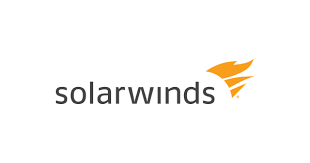
SolarWinds NPM is a feature-rich network monitoring tool that offers real-time network performance monitoring, advanced alerting, and reporting. Its unique features include support for deep packet inspection and network traffic analysis, as well as integration with other SolarWinds tools.
SolarWinds's Features
One of the key features of SolarWinds NPM is its ability to monitor network traffic and bandwidth usage. The tool provides detailed information about traffic patterns and identifies bandwidth hogs, helping administrators to optimize network performance. It also provides advanced network mapping and visualization capabilities, allowing administrators to easily identify network devices and their interconnections. The tool provides customizable dashboards and reports, making it easy for administrators to track key performance indicators and identify trends.
SolarWinds NPM supports a wide range of protocols, including SNMP, WMI, NetFlow, and more, making it easy to monitor a variety of network devices and applications. The tool provides comprehensive data collection and archiving for historical analysis and trending, allowing administrators to identify patterns and forecast future capacity needs. It also offers support for virtualization monitoring, including VMware and Hyper-V, making it easier for administrators to monitor and manage virtualized infrastructure.
In addition, SolarWinds NPM provides built-in security features, including SSL encryption and LDAP authentication, ensuring that sensitive data is protected. It also offers high availability and scalability, making it suitable for large and complex networks. Overall, SolarWinds NPM is a comprehensive network monitoring tool that provides a wide range of features for monitoring and managing networks. Its advanced network mapping and visualization capabilities, support for multiple protocols, virtualization monitoring, security features, and high availability and scalability make it an ideal choice for organizations of all sizes.
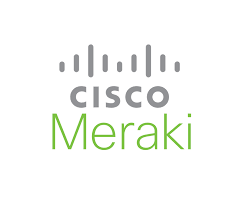
Cisco Meraki is a cloud-managed IT solution that provides a comprehensive suite of networking and security products. It includes wireless access points, switches, security appliances, endpoint management, and mobile device management. The platform is designed to simplify network management and enhance network performance and security.
Cisco Meraki's Features
Cisco Meraki’s main features include centralized cloud-based management, real-time visibility and control of network devices, easy deployment and scalability, and advanced security features such as malware protection, content filtering, and intrusion detection and prevention.
One of the key advantages of Cisco Meraki is its ease of deployment and management. The platform’s cloud-based management allows IT teams to easily set up and manage their network from anywhere, without the need for on-site hardware or complex configurations. This makes it an ideal solution for businesses with limited IT resources or those with distributed or remote locations.
Cisco Meraki is also known for its advanced security features, which help protect networks from threats such as malware, phishing attacks, and unauthorized access. The platform provides visibility into network traffic and allows IT teams to quickly identify and respond to potential threats.
Cisco Meraki is a robust IT solution that can help businesses streamline network management, improve network performance, and enhance security. It is used by a wide range of organizations, from small businesses to large enterprises, across industries such as healthcare, education, retail, and more.
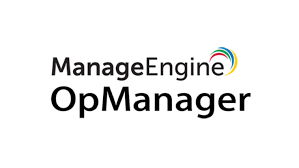
ManageEngine OpManager is a network monitoring tool that offers real-time monitoring and alerting, as well as advanced reporting and visualization features. Its unique features include support for SNMP, NetFlow, and WMI, as well as integration with other ManageEngine tools.
ManageEngine OpManager's Features
Network Discovery: OpManager automates the discovery of network devices and provides detailed information about the hardware and software configurations.
Real-time Monitoring: It offers real-time monitoring of network devices, servers, applications, and services to detect performance issues and outages.
Performance Analysis: OpManager provides in-depth analysis of network performance, bandwidth utilization, and traffic trends, enabling IT teams to identify performance bottlenecks.
Fault Management: It offers a comprehensive fault management system to troubleshoot issues quickly and reduce downtime.
Alerting and Reporting: OpManager sends alerts to IT teams in real-time when issues occur, and generates reports to provide insights into network performance and availability.
Multi-tenancy: OpManager enables managed service providers (MSPs) to manage multiple customer networks from a single console, providing them with granular control and visibility.
Network Automation: It provides network automation capabilities, allowing IT teams to automate routine tasks and streamline network operations.
ManageEngine OpManager is a paid tool, However, the companny offers a free version with limited features called OpManager Free Edition. This version is designed for small networks with up to 10 devices and includes basic monitoring and management capabilities.
If you need more advanced features, such as network discovery, traffic analysis, and automation, you’ll need to upgrade to one of the paid versions. ManageEngine OpManager offers several paid editions, including Essential, Enterprise, and MSP, which provide varying levels of functionality and support.
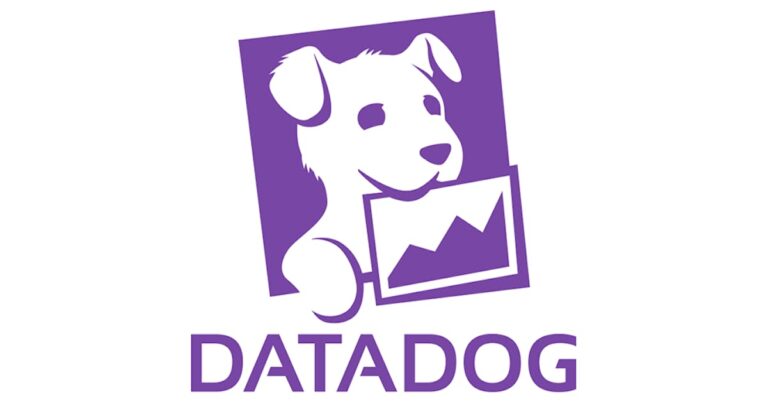
Datadog is a cloud-based monitoring and analytics platform that offers real-time visibility into network performance, as well as application and infrastructure monitoring. Its unique features include support for cloud-native technologies like Kubernetes and AWS, as well as customizable dashboards and alerts.
Datadog's Key Features
Real-Time Network Performance Monitoring: Datadog offers real-time monitoring of network devices and provides insights into network performance, including latency, throughput, and packet loss.
Network Traffic Analysis: It provides network traffic analysis to identify top talkers, monitor traffic patterns, and troubleshoot network issues.
Network Map Visualization: Datadog offers a network map visualization that helps IT teams to understand network topology and visualize relationships between devices.
Anomaly Detection: It uses machine learning algorithms to detect anomalies in network traffic and provide alerts to IT teams when issues occur.
Application-Aware Network Monitoring: Datadog offers application-aware network monitoring to correlate network performance with application performance and identify the root cause of issues.
Distributed Tracing: It provides distributed tracing capabilities that allow IT teams to trace requests across distributed systems and identify bottlenecks in application performance.
Network Device Inventory Management: Datadog offers inventory management capabilities to automatically discover network devices and provide detailed device information.
Collaboration and Reporting: It provides collaboration and reporting features that allow IT teams to share insights with stakeholders and generate reports on network performance and availability.
Datadog is a paid tool, however, it offers a trial version with limited features.

LogicMonitor is a cloud-based monitoring platform that offers comprehensive monitoring of network devices and services, as well as infrastructure and application monitoring. Its unique features include support for hybrid and multi-cloud environments as well.
LogicMonitor's Features
Automatic Discovery: LogicMonitor automatically discovers and monitors devices, applications, and services in your network infrastructure, allowing IT teams to quickly and easily set up monitoring.
Customizable Dashboards: It provides customizable dashboards and reports that allow IT teams to visualize network performance metrics and identify issues quickly.
Performance Metrics: LogicMonitor monitors a range of performance metrics, including latency, response time, availability, and throughput, to help IT teams optimize network performance.
Alerting and Notifications: It provides customizable alerting and notification features that allow IT teams to receive real-time alerts and take action to resolve issues quickly.
Predictive Analytics: LogicMonitor uses predictive analytics to identify trends and anomalies in network performance, allowing IT teams to proactively identify and resolve issues before they impact end-users.
Multi-tenancy: It offers multi-tenancy capabilities that allow IT teams to manage multiple customer networks from a single console, providing them with granular control and visibility.
Cloud Monitoring: LogicMonitor provides cloud monitoring capabilities, allowing IT teams to monitor the performance and availability of cloud-based infrastructure, applications, and services.
Integration and Automation: It offers integration and automation capabilities with popular IT management tools and platforms, allowing IT teams to streamline operations and automate routine tasks.
LogicMonitoring is a freemium tool that offers a trial version for a few days.
Now let's talk about some free (open source) network monitoring tools.
Nagios Core: Nagios Core is a widely used open-source tool that offers customizable monitoring of network devices and services. Its primary strength is its extensibility through plugins, which allows for customization and integration with other tools.

Nagios Core's Features
- Nagios Core allows users to monitor hosts, services, and network devices in real time.
- Users can visualize performance metrics and quickly identify issues using customizable dashboards and reports.
- Customizable alerting capabilities allow users to receive real-time alerts when issues are detected.
- Nagios Core is highly extensible and supports a wide range of plugins and extensions to customize the platform to meet specific needs.
- Nagios Core helps users to proactively identify and resolve issues, reduce downtime, and ensure business continuity.
Zabbix is a powerful open-source monitoring tool that offers real-time monitoring and alerting, as well as reporting and visualization features. Its highly customizable dashboard allows users to visualize network performance data and create custom alerts.

Zabbix's Features
- Comprehensive monitoring capabilities for network infrastructure, servers, applications, and services
- Supports agent-based and agentless monitoring
- Offers a range of monitoring methods, including SNMP, JMX, IPMI, and more
- Provides customizable dashboards and reports for visualizing performance metrics
- Offers flexible alerting capabilities, including email, SMS, and mobile push notifications
- Includes automation features, such as auto-discovery and auto-registration of hosts and services
- Supports external integrations, such as webhooks and APIs
- Offers a user-friendly interface and supports multi-tenancy
- Provides advanced features, such as trend prediction and capacity planning
- Supports high-availability and clustering for enterprise-level deployments
- Offers a range of professional services and support options
- Provides extensive documentation and an active user community
Icinga offers flexible monitoring of network devices, services, and applications. Its modular architecture and REST API allow for easy integration with other tools and automation workflows.
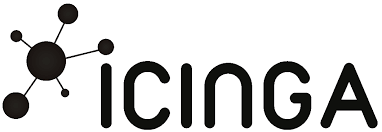
Icinga's Features
Multi-platform support: Icinga can be installed on a wide range of platforms, including Linux, Unix, and Windows.
Plugin-based architecture: Icinga uses a plugin-based architecture, which allows for easy integration with various monitoring plugins and extensions.
Flexible notification system: Icinga allows administrators to configure notification rules and escalation policies based on various criteria, such as severity and time of day.
Customizable dashboards and reports: Icinga provides customizable dashboards and reports that allow administrators to view and analyze monitoring data in real-time.
Integration with other tools: Icinga can be integrated with other tools such as Graphite, NagVis, and many more, which enhances its capabilities and provides a complete view of the IT infrastructure.
Performance data collection: Icinga can collect performance data for the monitored hosts and services, which allows for in-depth analysis and troubleshooting.
Distributed monitoring: Icinga supports distributed monitoring, which allows administrators to monitor multiple locations and networks from a single central location.
OpenNMS is an enterprise-grade open source tool that offers network performance monitoring, event management, and reporting. Its advanced features include support for SNMP, JMX, and NetFlow, as well as integration with other IT management tools.

OpenNMS's Features
- Automatic discovery and mapping of network topology
- Advanced event management with real-time notifications and escalation
- Customizable dashboards and reports
- Performance data collection and analysis for historical trends and capacity planning
- Advanced thresholding and root cause analysis to help identify and resolve issues quickly
- Support for a wide range of protocols including SNMP, JMX, WMI, and more
- Flexible and extensible architecture that supports customization and integration with other tools
- High availability and scalability to handle large and complex networks
- Support for fault management, configuration management, and asset management
- Integration with popular databases, notification systems, and other network management tools
- Comprehensive REST API for automation and integration with other systems
Cacti offers graphing and monitoring of network devices and services. Its strength is its ability to collect and display performance data over time, making it useful for trend analysis and capacity planning.

Cacti's Features
- Customizable and flexible graphs that can display a variety of metrics including network bandwidth, CPU usage, memory usage, and more
- Support for SNMP, which allows for monitoring of a wide range of devices including routers, switches, servers, and other network devices
- User-friendly web interface that provides easy access to monitoring data
- Automated graph creation and management, which saves time and reduces errors
- Multi-user support with customizable access control
LibreNMS is a fork of the discontinued Observium Community Edition, which is an open source tool for network performance monitoring. Its strength is its simplicity and ease of use, with a user-friendly web interface and support for SNMP, syslog, and API-based data sources.
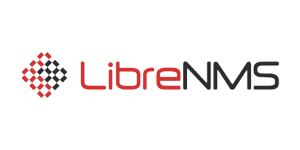
LibreNMS's Features
- Automatic discovery and mapping of network topology
- Support for SNMP, ICMP, and other protocols for monitoring network devices and servers
- Customizable dashboards and reports
- Performance data collection and analysis for historical trends and capacity planning
- Support for thresholding and alerting based on predefined metrics or user-defined thresholds
Netdata is a real-time monitoring and troubleshooting tool for Linux systems and applications. Its unique feature is its ability to provide real-time insights into system performance with a highly customizable and interactive dashboard.

Netdata's Features
- Real-time monitoring with automatic and dynamic visualization of key system metrics
- Support for multiple data sources and protocols, including SNMP, NetFlow, and more
- Advanced alerting and notification capabilities with customizable thresholds and triggers
- Distributed architecture for monitoring multiple servers and systems from a central location
Observium is a network monitoring and management tool that offers support for SNMP, Syslog, and NetFlow data. Its unique features include automatic device discovery and mapping, as well as detailed traffic analysis.

Observium's Features
- Automatic discovery and mapping of network topology
- Support for SNMP, ICMP, and other protocols for monitoring network devices and servers
- Customizable dashboards and reports
- Performance data collection and analysis for historical trends and capacity planning
- Advanced thresholding and alerting to help identify and resolve issues quickly
- Flexible and extensible architecture that supports customization and integration with other tools
Munin uses a client-server architecture, where the Munin server collects data from the Munin nodes, which are the systems being monitored. The data is collected using plugins, which are small scripts that run on the Munin nodes and collect specific metrics.
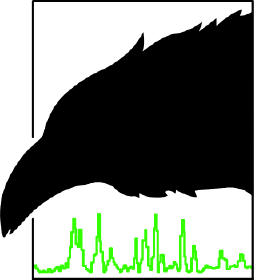
Munin's Features
- Extensible architecture with support for plugins and extensions to customize monitoring capabilities
- Centralized management with support for distributed monitoring
- Thresholding and alerting capabilities to notify administrators when system performance issues occur
- Comprehensive data collection and archiving for historical analysis and trending
Conclusion
Thus, After exploring 17 of the best network monitoring tools, it is evident that Auvik is a clear winner due to its unique features, benefits, and user-friendly platform. Auvik is a cloud-based networking monitoring tool that offers automated network discovery, real-time network mapping, and comprehensive device monitoring in a single platform. Auvik is best suited for IT teams and individuals that need comprehensive network monitoring and management capabilities, especially those with complex network infrastructure. It is also an excellent choice for managed service providers (MSPs) who need to manage multiple client networks efficiently.